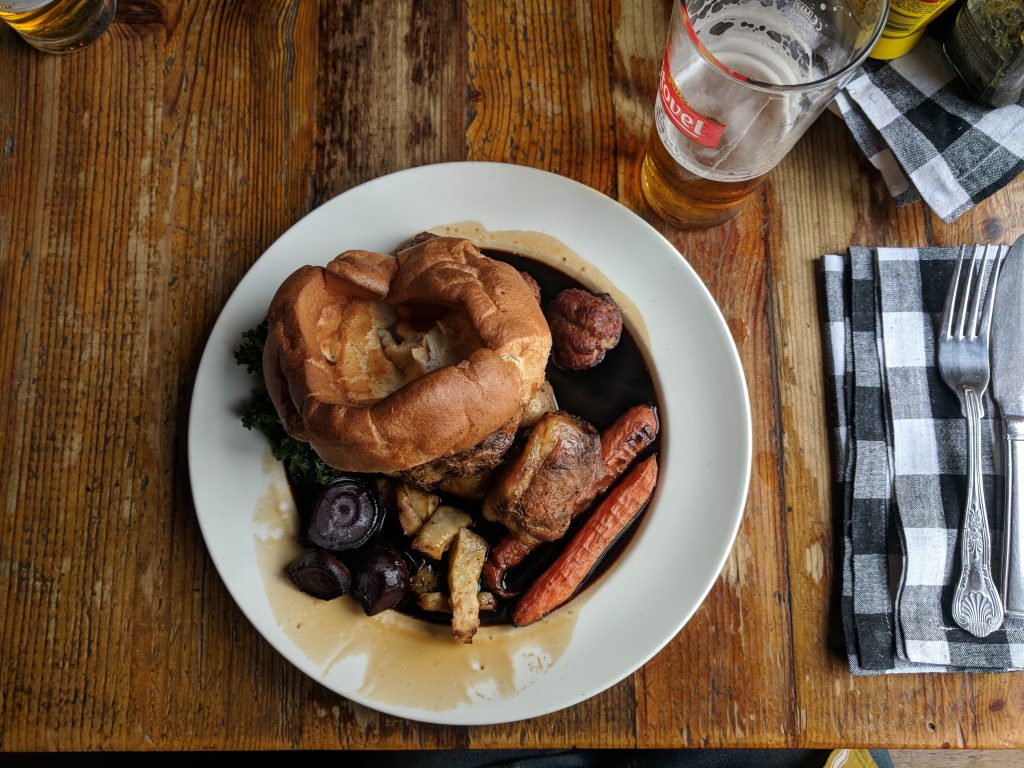I’ve just spent nine hours on a flight to travel to a foreign country. I meet with Miko and soon we are driving to the southern coast of England. We drop our bags and head to the nearest pub for food and a drink. I survey the menu and while I consider myself quite fluent in the English language, I don’t recognize any of the items listed on the menu. Bubble and squeak, bacon bap, mushy peas — I’m reading English but not understanding what is in front of me. It makes me think, ‘why this food is so different than what I grew up eating! So new. So exotic!’
Thus begins my adventure into British cuisine…
Sunday Roast

Sunday roast with pork
A beloved English tradition born in the 1400s, Sunday roast has become a favorite of Brits. A huge plate of roasted meats, veggies, and a few other foreign sides make up this weekly tradition. According to multiple sources, the Sunday roast began as a post-church meal, with Sunday being the easiest day to gather the whole family. The story is that the men would help prepare the meat, peel potatoes, and then find themselves at the pub for a few pints while the women cooked. The women would handle the cooking and once the men returned from the pub, they would all eat a massive meal. Also to be noted is that the Brits love beef, so much in fact that King Henry VII’s guard became known as the Beefeaters because of their weekly meal of roast beef.
So with all of the background, we catch up to 2018, when I had my first proper sunday roast. Our guide Ryan, along with Miko, and I made it over to Hoxton’s The George & Vulture for the Bacchus Sunday. Bacchus Sunday was birthed from Bacchus Pub & Kitchen and now aims to serve their roast dinner at multiple venues across the town of London.
We started with a pint and selected our meat of choice for our roast. The choices included beef, pork, duck, chicken, vegetarian, vegan, and a mixed meat plate. We each opted for a different meat and we were served a massive platter of food. I ordered the pork plate and received a massive mound of well cooked pig, roasted potatoes, parsnips, kale, beets, carrots, pork stuffing meatballs, and Yorkshire pudding all soaking in a clear gravy. I was overwhelmed. With instruction from our chaperone, I experimented by adding some apple sauce, mint sauce (so exotic!), mustard, and a homemade horseradish that was excellent. We finished our plates, had another pint for good measure and fatly walked through Brick Lane for a bit of calorie burning and remorse.
Full English Breakfast

A full English breakfast
Breakfast with beans, tomato and tons of meat? An intimidating woman with a booming voice, shouting your order off in foreign jargon? A cafe full of middle-aged British men during their break from the office/work site? Of course, I loved my first English breakfast experience.
We headed to Regency Café in Pimlico for my first official fry-up and I was not disappointed. I opted for coffee with a fry-up and black pudding that cost about 7 quid (the local currency). Once the meal arrived I happily stuffed my face, slurped on my coffee and dipped my bites with HP (aka “brown”) sauce. I was overwhelmed by the amount of food and how quickly I devoured the giant breakfast. My recommendation for your first fry-up is to drink way too much the night before, wake up and get yourself a giant plate of this comfort food, then finish with a nap. You can see me before my food was delivered—in superb form after a late night at the pub.

Hung over Justin, waiting for food
The history of the English fry-up is well documented and believed to have been born from the Gentry wanting to host and feed their guests. Usually consumed before a day long hunt, the breakfast gave the hosts a chance to show off the wealth of their lands. Meals included meats, vegetable, and grains that were gathered from their lands and was prepared using Anglo-Saxon recipes.
The modern fry up can be found all over the UK and is a staple for all levels of society. The common version features back bacon, eggs, British sausage, baked beans, fried tomato, fried mushroom, black (blood) pudding, and toasted bread. There is a huge difference of opinion about other ingredients that should or should not be included with the meal. The region also influences what is served for a fry up, for example, the Irish serve their meal with Irish bacon, sausage, white pudding, Irish soda bread, and Irish potato cake compared to Scottish, which has black pudding or a slice of haggis.
We had another experience with some friends on our last morning in London, at Canary Wharf’s St. George’s of Mayfair. It was the same great experience, same hangover but less shouting. By this time I was a pro and doused my eggs and meats in brown sauce like a regular ol’ chap.
Scotch Egg

Scotch Egg!
Justin overly excited for his first Scotch Egg
“So I got this great idea… let’s get a cooked egg, wrap it in minced meat, THEN FRY IT!”
Unknown Genius
This might be one of the most absurd things I’ve eaten in England. It is an amazing triumph of cooking technique to bring these delicious ingredients together into a handheld snack. We headed to Scotchtails in Borough Market to get a fix and was greeted by this delicious snack. There has been a bit of contention about whether Fortnum & Mason was the actual creator of the Scotch Egg or if it was a copy of the Mughlai dish nargisi kofta. They are essentially the same dish but the Mughlai version is served in a gravy featuring garam masala, ginger, and peppers.

Overly excited justin
The outside is crunchy, salty from the minced meat, and the egg on the inside makes for an indulgent snack. While I had my first scotch egg on the street, I would highly recommend tucking into a pub, get a pint, and an order of this fried treat!
Pie + Mushy Peas

Pie and Mushy peas covered in brown gravy
One thing I adore about English food is the names for certain dishes. Bangers (sausages) for example, were named after the sounds made from the sputtering of water in oil. After World War II there was a shortage of meats, so butchers ‘extended’ their supply by adding lots of cereals that caused the sausages to have more water than usual.
Mushy Peas is exactly what it sounds like, peas that are mushed. I grew up hardly eating peas — my dad used to make his version of sloppy joes that made use of peas and ground beef in a gravy made mostly with cream of mushroom. My mom detested peas after being forced to eat them as a child. They were served overcooked and from a can, so my pea experience was limited and never mushy.
We were hard at work when we visited Pieminister at Borough Market, and I had my first pie and mushy peas. The meat-filled savory pie was flaky on the outside and filled with beef, carrot, and potato. Served in a to-go container with mushy peas smothered with gravy. It was a heavy meal for the middle of the day — one that might be better for someone burning more energy than a London tourist. The mushy peas are one of the better ways I’ve eaten the pod fruit, and there are never any complaints from me when my food is covered in a brown gravy.
The exotic nature of British food is one that has me intrigued. After years of people bashing the cuisine, I think it’s safe to say that there are some stars among the dark sky of the British food landscape. I’ve only just scratched the surface of this cuisine and it’s gotten me thinking I need beans served with every breakfast from here on out. We haven’t even mentioned the other famous foods like fish & chips, jellied eels, or a bacon bap! Stay tuned and keep eating.